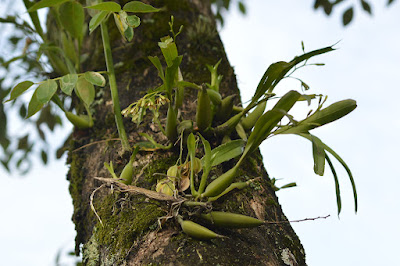Prosthechea livida - Bluish Prosthechea flowers are inconspicuous, 1.8 cm in diameter, brown reddish to greenish. Sepals are green outside...
Prosthechea livida, also called as Bluish Prosthechea, Anacheilium lividum, Encyclia deamii, Encyclia livida, Encyclia tessellata, Epidendrum articulatum, Epidendrum condylochilum, Epidendrum dasytainia, Epidendrum deamii, Epidendrum henrici, Epidendrum lividum, Epidendrum tessellatum, Pollardia livida, Pseudencyclia livida, is a species in the genus Prosthechea. This species was described by Wesley Ervin Higgins in 1998.
DESCRIPTION OF PROSTHECHEA LIVIDA - BLUISH PROSTHECHEA
Prosthechea livida is native to Mexico to Ecuador. It is found growing on cacti, trees and rocks in very wet areas in humid, seasonally dry forests in Belize, Colombia, Costa Rica, Ecuador, El Salvador, Guatemala, Honduras, Mexico Gulf, Mexico Northeast, Mexico Southeast, Mexico Southwest, Panamá, Venezuela at elevations of 0-1600 meters above sea level.
It is a small sized, hot to cool growing, mat forming epiphytic species with ellipsoid, lightly complanate, to 5 cm long pseudobulbs that are covered with scarious sheaths when young. The leaves are 1 or 2 apical, oblong-elliptic, attenuate to conduplicate into the petiolate base, acute to minutely bilobed apically, thin, dark green, to 12 cm long.
Bluish Prosthechea blooms in the late fall and winter from the apical, 4 to 11 cm long, 3 to 7 flowered inflorescence that arise on a mature pseudobulb. The flowers are inconspicuous, 1.8 cm in diameter, brown reddish to greenish. Sepals are green outside, underside with greenish background, longitudinal, transverse nerves are reddish-brown quadrate. Petals are spatula-shaped and quadrate as sepals. Lip adnate to the base of the column, cream-yellowish background with purple nerves. Disc with a purple callus over a white background which disintegrates into several verrucose calli, irregular and whitish on a reddish background, wavy edges. Column is yellowish, brown-reddish on top and trilobed at the apex.
PROSTHECHEA LIVIDA - BLUISH PROSTHECHEA CARE AND CULTURE
Cultural information should only be used as a guide, and should be to be adapted to suit you. Your physical location; where you grow your plants, how much time you have to devote to their care, and many other factors, will need to be taken into account. Only then can you decide on the cultural methods that best suit you and your plants.
Light:
Prosthechea livida needs a light level of 25000-35000 lux. The light should be filtered or diffused and the plants should not be exposed to direct midday sun. Strong air movement should be provided all the time.
Temperature:
In summer, the average day temperature is 27-30 °C, and the night 17-19 °C, with a daily amplitude of 8-10 °C. In winter the average daytime temperatures are 25-27 °C, and 16-18 °C during the night, while the daily amplitude is 8-11 °C.
Humidity:
Bluish Prosthechea needs the humidity of 80% in the period of growth, in winter and spring it falls to 60-70%. Too dry air has a negative effect on the development of the plant: its growth is inhibited, and the leaves begin to turn yellow and dry out. The higher temperature, the higher the humidity should be, and the higher the humidity, the more often and longer it is necessary to ventilate the room where the plants are contained, otherwise the probability of rotting and various kinds of fungal diseases. Good air movement is essential while the plants are in leaf and growing.
Substrate, growing media and repotting:
Prosthechea livida are most often grown in pots or baskets with a very thick, loose and well-drained substrate. There should be plenty of space in the pots to allow the roots to dry quickly after watering. It is recommended to use smaller pots sufficient for only one or two years of growth, because the substrate in larger pots remains wet after watering for too long. Roots that do not dry out quickly enough after watering rot. Most growers recommend medium grain bark, though others prefer medium cork pieces mixed with large lumps of charcoal.
The plants also grow well mounted on tree-fern or cork rootstocks, provided that high humidity is ensured. Fixed plants require high humidity and at least daily watering in summer, and in the case of dry and hot weather, it may be necessary to water several times a day.
Transplanting or splitting is best done when new roots begin to emerge, or immediately after blooming. This allows the plants to acclimate in a relatively short time and provides them with the least stress.
Watering:
The plants should be watered abundantly during active growth, but their roots must dry out quickly after watering. At the end of autumn, the amount of water should be gradually reduced.
Fertilizer:
Bluish Prosthechea should be fertilized every week 1/4-1/2 of the recommended dose of fertilizer for orchids. A fertilizer with a high nitrogen content is beneficial from spring to mid-summer, and a phosphorus-rich fertilizer can be used in late summer and autumn. Higher phosphorus content stimulates better flowering in the next season and promotes hardening of new growth before winter.
To avoid the accumulation of mineral deposits during periods of strong fertilization, it is recommended to rinse the containers approximately every month.
Rest period:
Prosthechea livida grown in cool conditions should be kept relatively dry in winter, with occasional fogging between rare waterings. However, those grown in warmer conditions need more water and significant drying up between waterings. However, it must not be allowed keep them dry for a long time. Fertilization should be reduced or eliminated until new growths appear and watering begins more abundantly in the spring.















COMMENTS